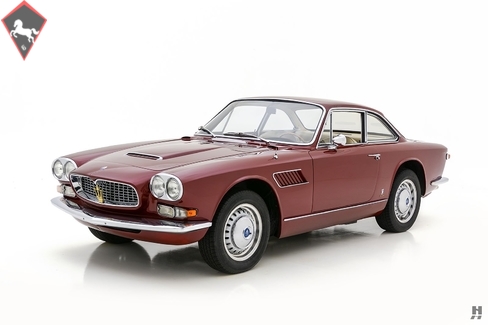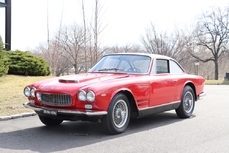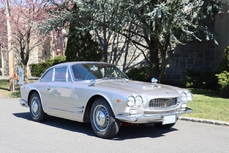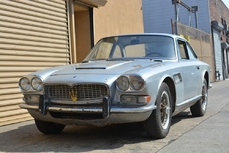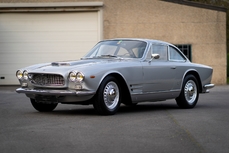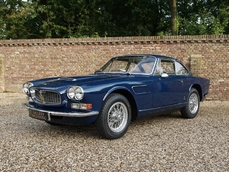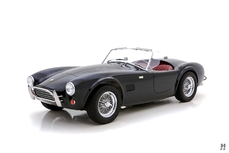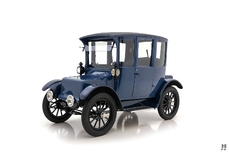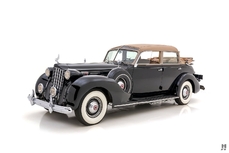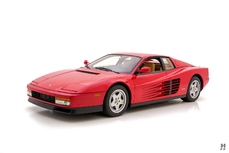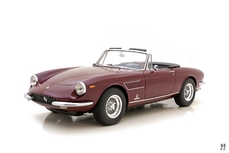Maserati Sebring Coupe 1965
General description :
The pinnacle of Maserati’s legendary motor racing accomplishments came in the 1950s and early 1960s with cars such as the iconic 250F Grand Prix car, and a series of innovative sports racers including the A6G, 300S, and Tipo 61 “Birdcage.” Like their rivals at Ferrari and Lancia, motorsports directly influenced Maserati’s road cars, but even well into the 1950s, they were still only a boutique manufacturer that trickled out the occasional road car for the purpose of funding their racing exploits.
The Maserati brothers had no interest in building road cars, and departed to form OSCA in 1947. By the early 1960s, Maserati’s wealthy-industrialist owner Adolfo Orsi found himself in some financial difficulties, and needed a way to boost sales by a significant margin. Orsi tapped his gifted engineer Giulio Alfieri to design a new GT car that could finally establish the marque as a volume manufacturer. Alfieri created a tubular chassis design which he paired with a 3,486cc inline-six with dual overhead camshafts to form the new 3500 GT. The engine shared its roots with the 350S sports racer, which itself was based on the 250F Grand Prix car, so it had a proven lineage. Unlike Mr. Ferrari, Alfieri was a proponent of technology like disc brakes on all four wheels and even fuel injection. The 3500 initially wore triple Weber carbs, then Alfieri adapted the sophisticated Lucas P.I. fuel injection system which boosted horsepower by about 20. He later increased displacement from 3.5 to 3.7, then 4.0 liters for even more grunt. Maserati did very well with the 3500, outselling Ferrari regularly and cementing Maserati’s status as a fullfledged manufacturer of beautiful, high-performance GT cars.
The chassis of the 3500 GT served as the basis of several models, including the shortenedwheelbase Sebring 2+2, and the lighter, stiffer Frua-bodied Mistral. With the Vignale-bodied Sebring, Maserati targeted Ferrari’s primary audience in America. The car was shorter and slightly sportier than a 3500, but it still offered two occasional rear seats, a spacious cabin, and available niceties such as air conditioning and even an automatic transmission. Such luxuries appealed particularly to American buyers, and Maserati sold approximately 600 examples worldwide between 1962 and 1966. The Sebring proved to be a terrific driver’s car, with the gutsy twin-plug, dual-overhead-cam inline-six, and luxurious cabin. The handsome styling by Giovanni Michelotti for Vignale, bore a strong resemblance to the 3500 GT, with an understated sophistication that defined Maserati’s superb Gran Turismos of the era.
Presented here in its original colors of Rosso Cordoba over Pelle Neutra, this 1965 Sebring 3500 GTI is a superb example of Maserati’s handsome high-performance grand tourer. This car is exceptionally well-documented with factory records and is one of just 94 Series II Sebrings equipped with the injected 3.5-liter inline-six. The factory build order reveals this car, chassis number AM101/10.021, was completed in March 1965, then shipped to its first owner via Belgian Distributor Mr. Francois Staumont, of Brussels. Original equipment listed on the build sheets includes Borrani disc wheels, ZF 5-speed manual gearbox, electric clock, color-matched carpets, and an optional Nardi sports steering wheel. The car remained in Belgium for many years before coming to the United States with its second owner, who commissioned a high-quality ground-up restoration of the low-mileage original car, ensuring it stayed remarkably true to original specification.
In the time since its restoration, this Sebring has enjoyed a charmed life of consistent care, and it remains in excellent condition. The gorgeous Rosso Cordoba color has a subtle hint of metallic that suits the smart Vignale lines, and the paint quality is excellent. Panel gaps are tight and even, and the doors fit properly. The brightwork is superb, with straight alloy window surrounds, and sill trims, and lovely bumpers showing only some light polish marks on the surface. The car retains the distinct Borrani Turbosport alloy wheels, which are in good condition all around.
Maserati has always offered uniquely stylish interiors, and the Sebring is no exception. This car’s light beige leather is in excellent condition, displaying just enough character in the leather to invite regular use. The original toggle switches and heater slides are excellent and retain the oftmissing identifying decals and labels. The gorgeous optional wood-rimmed Nardi wheel remains in place, as does the original wood shift knob for the ZF 5-speed gearbox, Smiths instruments, and a period-correct Novak radio. This fabulous Sebring offers practicality and style, ideal for long-distance enjoyment.
The original, numbers-matching 3.5-liter inline-six sits under the bonnet. It presents correctly with wrinkle finish cam covers and plenums, and importantly, it retains the original Lucas P.I. fuel injection system. Records show Lucas specialists Power Props of the Netherlands completely restored the system, and it remains in proper working order. In the spring of 2019, the brake system, clutch hydraulics, cooling system, and ignition received comprehensive servicing. The undercarriage is clean and tidy, befitting a well-maintained car that has seen consistent use.
This rare and desirable numbers-matching Sebring benefits from long-term care with attentive owners, and it presents beautifully with an honest, usable character. Comfortable, practical, and with a robust race-bred drivetrain, this elegant Sebring is the quintessential 1960s Maserati and superb Grand Touring car in the finest Italian tradition.
Offers welcome and trades considered
1965 Maserati Sebring Coupe is listed for sale on ClassicDigest in St. Louis by Hyman Ltd. for $265000.
Car Facts
Car type : Car Make : Maserati Model : Sebring Model Version : Coupe Engine size : 0.0 Model Year : 1965 Sub type : Coupé Location : Missouri Vehicle Registration : Undefined
265000 $
People who viewed this Maserati Sebring also viewed similar Maserati listed at ClassicDigest
Other cars listed for sale by this dealer
About Maserati
Maserati, the epitome of Italy's finest traditional luxury sports cars. Let's dive into the captivating narrative of Maserati's storied history, shall we?Act 1: The Roaring Twenties
In the heart of Bologna, Italy, Maserati was born in 1914, founded by the Maserati brothers. The roaring twenties saw Maserati establishing itself as a force in racing, capturing hearts with its precision engineering and sleek designs.
Act 2: The Trident's Triumphs
The iconic Trident logo emerged in the 1920s, symbolizing Maserati's dominance in the racing world. Models like the Tipo 26 and the 250F graced the tracks, with the latter securing Juan Manuel Fangio's Formula One World Championship in 1957.
Act 3: The Road Cars Roar (1960s-1980s)
Maserati transitioned from racetracks to the streets, introducing luxurious grand tourers. The Ghibli, a name evoking the desert wind, and the stunning Bora and Merak, with their mid-engine designs, became symbols of automotive elegance.
Production Numbers:
Ghibli (1967-1973): Approximately 1,170 units.
Bora (1971-1978): Around 524 units.
Merak (1972-1983): Approximately 1,830 units.
Act 4: Turbulence and Triumphs
The '80s brought challenges, but Maserati persisted. The Biturbo series aimed to bring the brand to a broader audience, blending performance and luxury. Amid ownership changes, Maserati's spirit endured.
Production Numbers (Biturbo Series):
Biturbo (1981-1994): Over 38,000 units.
Finale: Modern Elegance and Power
Entering the 21st century, Maserati merged tradition with modernity. The Quattroporte, GranTurismo, and Levante continued the legacy, blending Italian craftsmanship with cutting-edge technology.
Maserati, with its timeless Trident emblem, stands as a testament to Italian passion for both racing and luxurious craftsmanship. Through triumphs and tribulations, Maserati has etched its name in the annals of automotive history as a symbol of style, performance, and the pursuit of perfection. See also BiTurbo restoration story: https://www.classicdigest.com/readers-stories/Andreas/713
